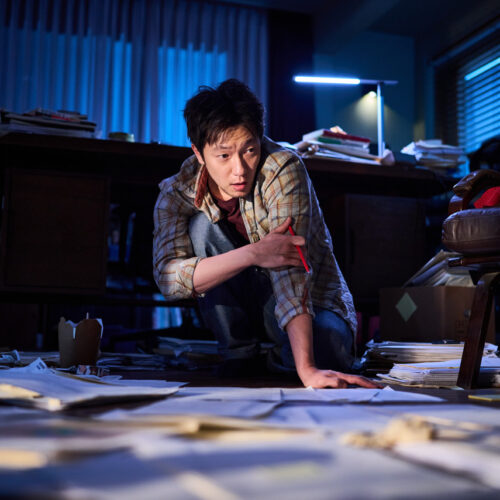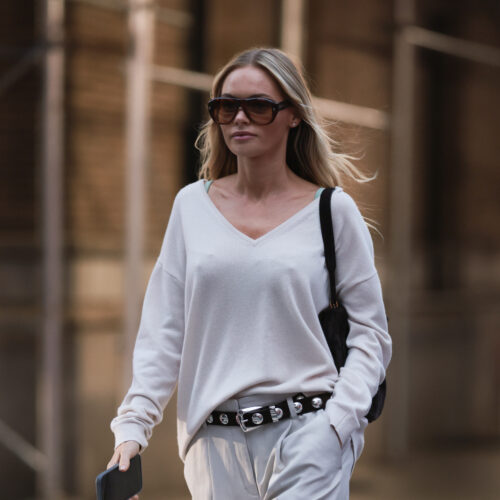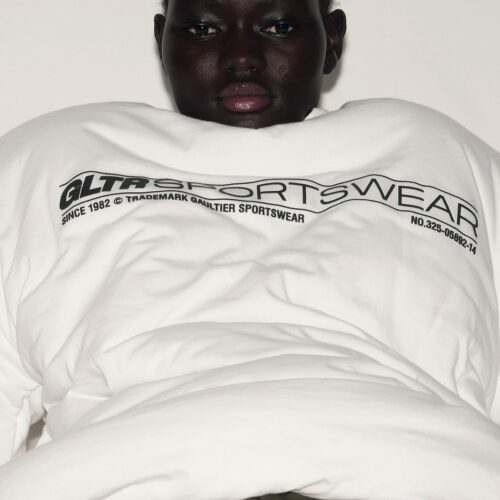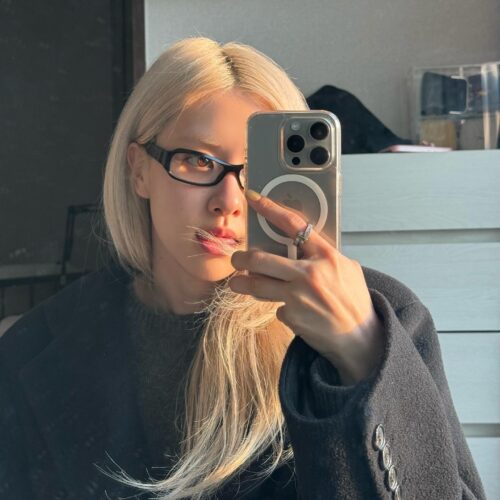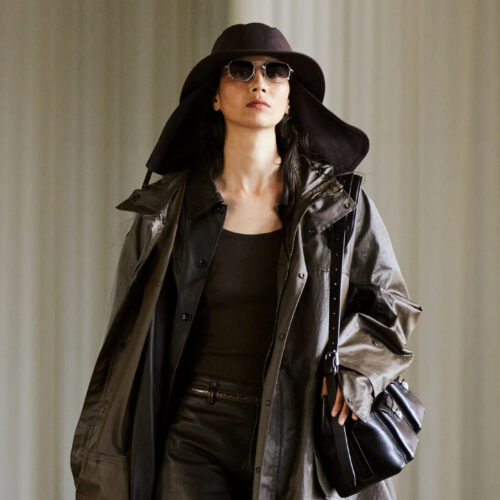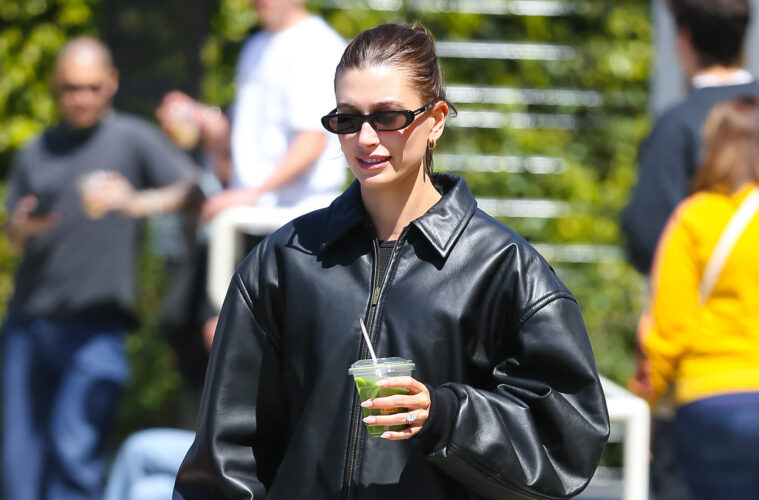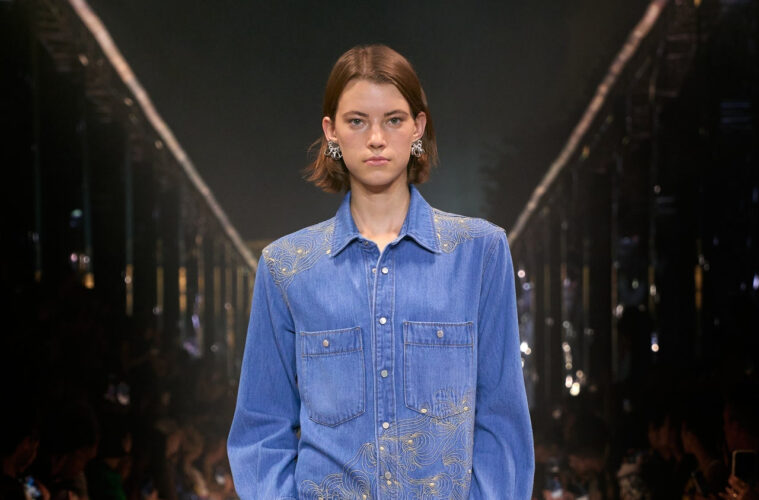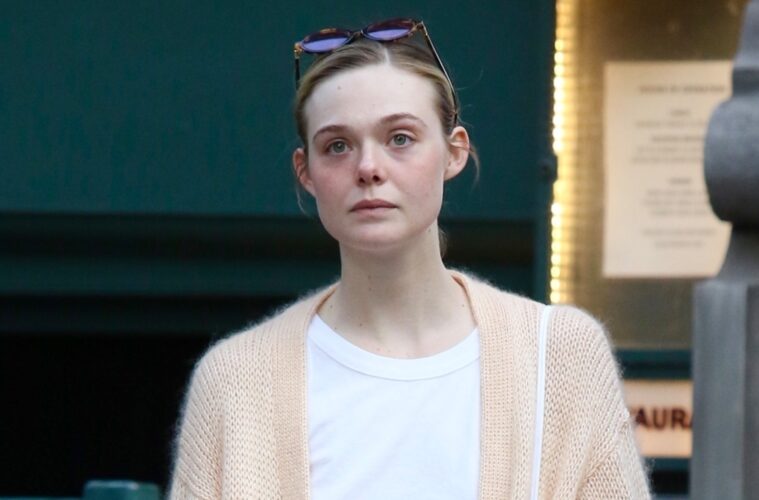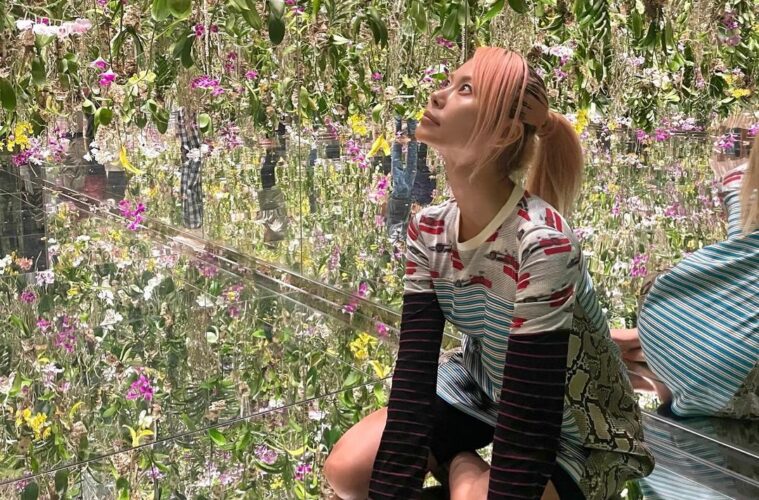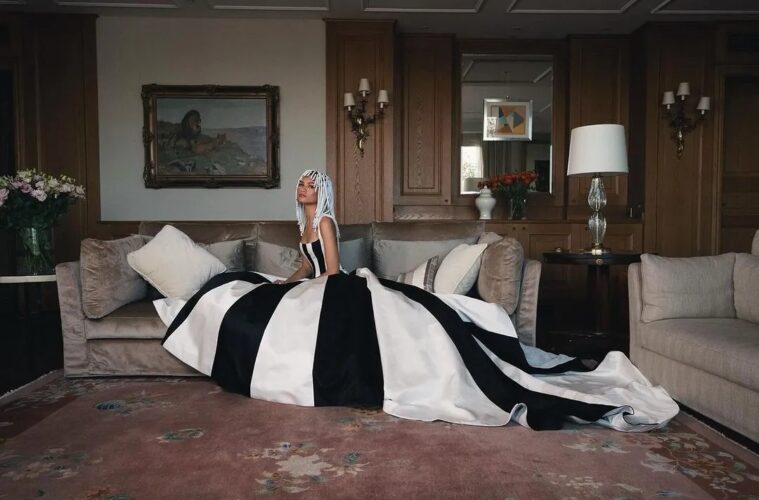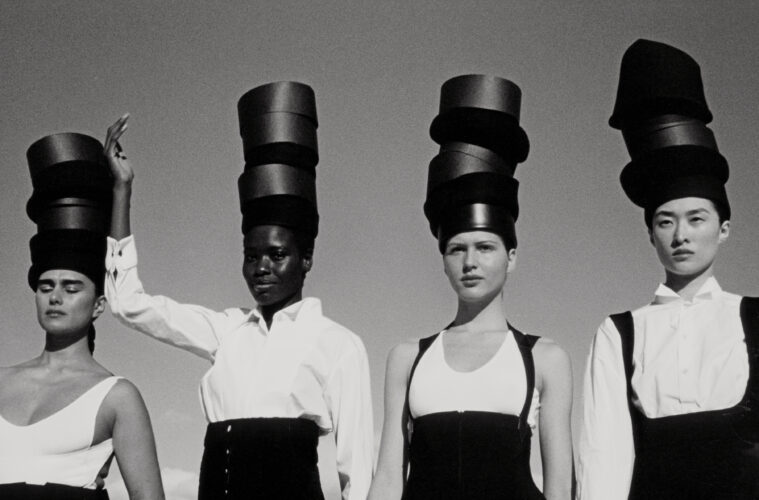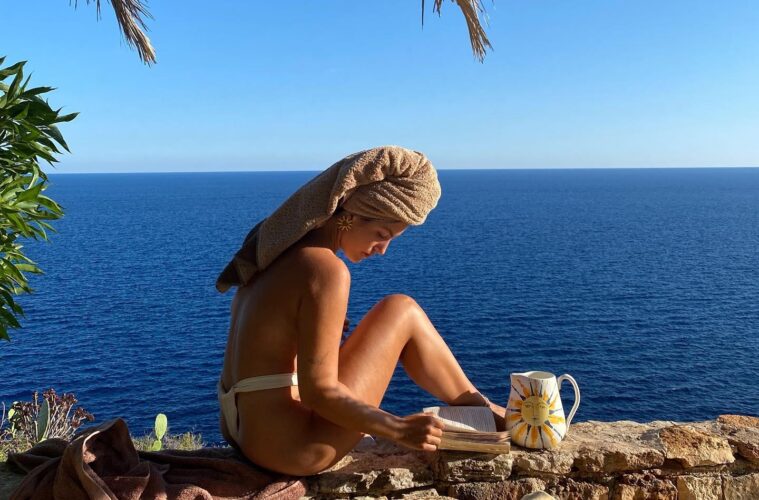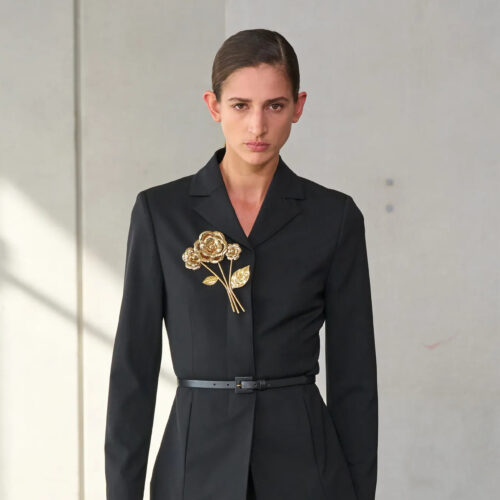경이로움을 포착한 V&A 뮤지엄의 ‘호르스트’ 전시 속으로!
‘보그 인터내셔널 에디터’ 수지 멘키스는 세계에서 가장 유명한 패션 저널리스트다.
<인터내셔널 헤럴드 트리뷴>(현재 <인터내셔널 뉴욕 타임즈>로 이름이 교체됐다)에서 25년 간 패션 비평을
담당한 그녀는 현재 세계 각국의 ‘보그닷컴’을 위해 독점 취재 및 기사를 쓴다.
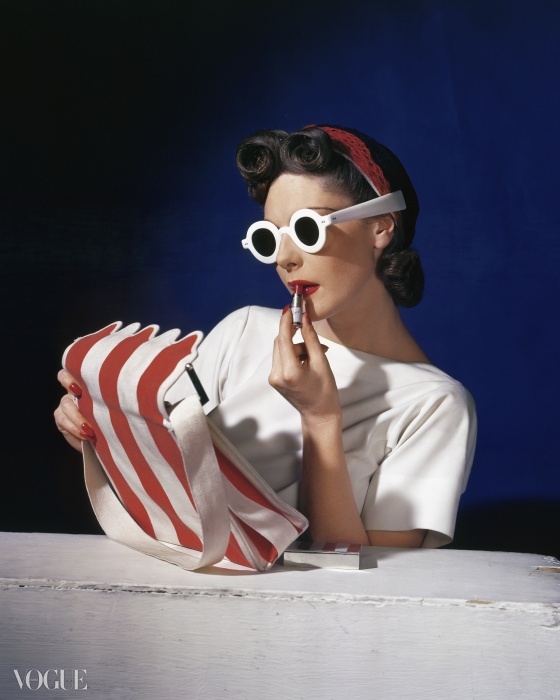
제도사의 설계 도면처럼 흑백 그래픽 라인들이 그려져 있다. 그 선들은 기하학적 마루바닥의 패턴을 따라 가다 우아한 모델들의 사진 액자를 지나 마네킹들이 입은 드레스까지 이어지면서 좁은 공간을 가로지른다.
런던 빅토리아&앨버트 뮤지엄에서 열리는 이번 전시회의 오프닝 때, 벽에는 선명하고 입체적인 글자체로 한 단어가 적혀 있었다. ‘H O R S T.’
이 전시는 60년 동안 왕성한 활동을 펼치며 바우하우스에서 고급 패션으로 옮겨간 사진작가에 대한 오마주다. 그 결과물은 큐레이터 수잔나 브라운의 승리다. 그녀가 기획한 전시 <Horst: Photographer of Style>(1월 4일까지)는 호르스트는 물론, 그의 작품들의 정밀함과 명료함을 담고 있다. 그것은 빛과 그림자의 우아한 명암대비(30년대에 호르스트는 이것으로 유명했다)를 보여주는 아이콘적 사진들에 대한 연구로 시작된다.
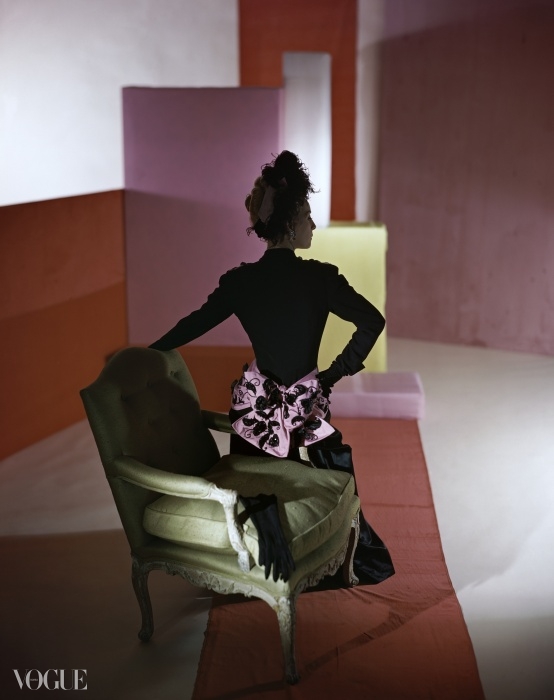
전시는 계속해서 살바토르 달리와 초현실주의자들에 대한 호르스트의 애착, 리타 헤이워스와 진저 로저스 같은 은막의 스타들의 엄격한 포트레이트 사진들을 보여준다. 마지막 색채의 폭발은 최근 콘데나스트 아카이브의 자료 중 새롭게 인화한 <보그> 표지 94점과 거대한 사진 25점으로 나타난다. 전시는 전체적으로 강렬한 에너지와 심오한 지식을 담은 동시에 아주 섬세하게 표현됐다.
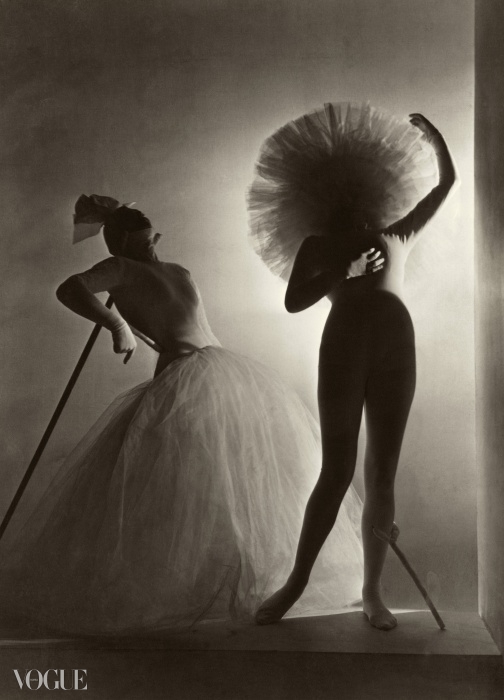
수잔나 브라운은 호르스트 전시의 일부를 그의 사적인 작품들의 양식화된 에로티시즘에 할애했다. 50년대에 근육질 남성들의 몸이 뒤엉킨 사진 같은 것들 말이다. 이것은 80년대 로버트 매플소프의 좀더 노골적인 작품보다 앞선 것이다. 카메라 렌즈를 통해 연출된 호르스트의 몸 조각들은 ‘엘튼 존/데이비드 퍼니시’의 개인 컬렉션에서 빌려왔다는 것을 밝힌다.
나는 호르스트와 일해 본 적 없지만 그에게 특별한 친밀감을 갖고 있다. 내가 <The Winsor Style>(윈저 공작 부부에 대한 책)을 쓰기 위해 사전조사 할 때 호르스트의 오랜 파트너인 발렌타인 로우포드(Valentine Lawford)가 나를 롱 아일랜드 오이스터 베이에 있는 그들의 집으로 초대했기 때문이다. 그곳에서 나는 1930년대 건축가 르 코르뷔지에의 견습생활을 통해 탄생한 모더니즘을 엿보았다. 그 간결한 스타일 사이사이에 크리스티앙 베라르(Christian Bérard)의 드로잉 작품들, 컬러풀한 튀니지 패턴 러그들, 집 둘레에 우거진 정원 등 낭만척인 터치들이 가미됐다.
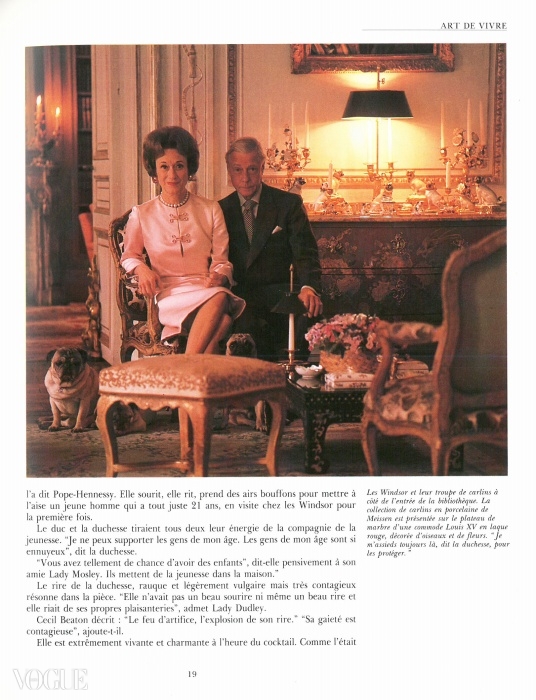
발렌타인 로우포드는 1947년 두 사람이 사랑에 빠졌을 때와 마찬가지로 여전히 흠잡을 데 없는 영국 외교관이었다. 우린 함께 구두 상자에 담긴 자료들을 뒤지며 퇴위하기 전 왕실에서 쓰던 물건들로 장식된 파리 저택에서 찍은 윈저공작 부부의 사진과 월리스가 개인적으로 수집한 마이센 도자기 퍼그(그녀의 발 밑에 앉아 있는 살아있는 동물들에게 어울리는)의 사진을 봤다.
호르스트의 작품들은 대부분 아주 유명하다. 이 말은 이 아이콘적인 사진들의 피사체가 친한 친구들이라는 걸 의미한다. 소파에 길게 누운 코코 샤넬, 그녀가 사랑을 담아 먼 곳을 바라볼 때 조각한 듯한 옆모습은 부드러워 보인다. 또 수수한 검은 수트와 반쯤 감긴 스모키한 눈 위로 모자를 쓴 마를렌 디트리히!
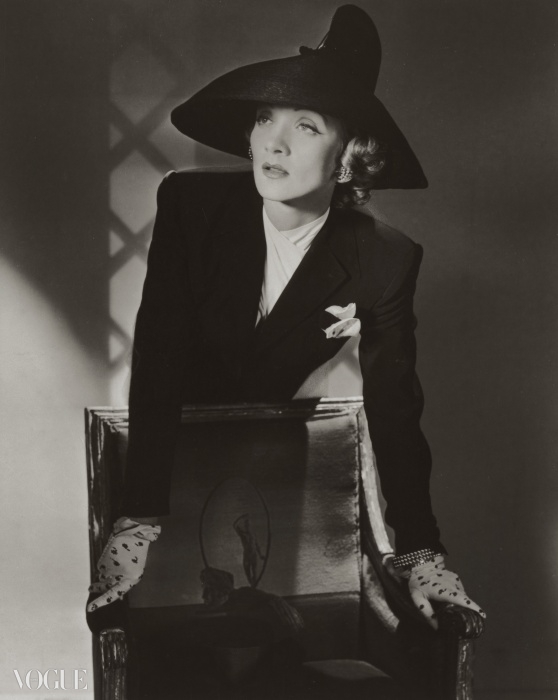
그리고 진정 ‘아이콘’이라 묘사할 수 있는 사진이 있다. 호르스트가 전쟁 시작 무렵 파리에서 뉴욕으로 도망가기 전에 찍은 멩보쉐(Mainbocher)의 레이스 코르셋 사진(1939년 작)이 그것. 모델들만 봐도 전설적이다. 때론 1941년 뉴욕의 뾰로통한 미녀인 글로리아 발더빌트 같은 사교계 여성, 고전적인 검정 샤넬을 입었을 때만큼 몰리노(Molyneux) 레오파드 스킨을 입었을 때도 여전히 우아한 스웨덴 모델인 리사 폰사그리브스 등등.
큐레이터는 호르스트를 ‘빛의 마술사’라고 부른다. 그리고 그녀는 아름다우면서도 친근한 이미지들이 완성돼가는 과정에 찍힌 사진들을 발견했다. 덕분에 우리는 포트레이트 사진을 찍는 과정을 이해할 수 있다. 예를 들어 카르멘 델로피체(Carmen Dell'Orefice, 호르스트의 모델 중 아직까지 생존해 있는 유일한 여성)는 1946년 얼굴 마사지를 받는 모습이 사진에 찍혔다. 그 이미지는 처음엔 곧이곧대로 찍혔고 그 다음엔 출판된 것처럼 극적인 각도로 찍혔다.
전시회와 함께 출간된 책 속에서 델로피체는 호르스트가 어떻게 자신의 머리카락 뒤에 숨겨진 고전적인 아름다움을 봤는지 설명한다.
이번 전시에 진열된 옷들은 샤넬, 랑방, 매기 루프(Maggy Rouff), 그리고 비오네 같은 그 시대를 대표하는 디자이너들의 작품이다. 그 옷들은 주변에 걸려 있는 사진들 속에 등장한 것과 똑같은 것은 아니지만 비슷한 패션 표현을 담고 있다. 흐르는 듯한 메탈릭 소재들, 혹은 거울 벽에 반사된 등 쪽의 리본들과 드레이프. 옷들이 너무 작아 뮤지엄 측은 마네킹을 맞춤 제작해야 했다.
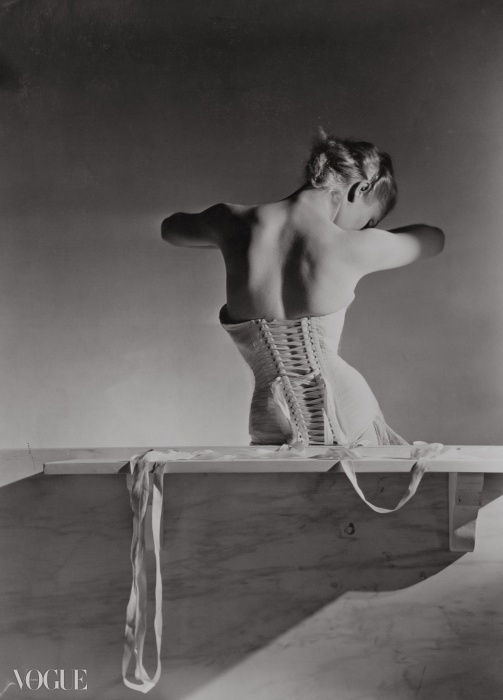
빛과 그림자가 주제인 첫 번째 방에서 밝고 대담한 달리 시대로 옮겨갔을 때의 충격은 의도적이었고 효과가 있었다. 엘자 스키아파렐리와 달리와 함께 만든 호르스트의 작품들로 이뤄진 이 섹션은 시각 예술이 두 번의 세계 대전 전에 다작하던 그 파리 시절과 얼마나 많은 연관이 있는지를 강조한다.
다시 한번 이 전시는 놀라움을 선사한다. 다른 드로잉 북들이 페이지가 넘어가도록 디지털화되어 전시되는가 하면 멩보쉐 코르셋 이미지를 그린 호르스트의 오리지널 연필 스케치들도 있다. 또 다른 21세기 기술의 쾌거는 호르스트가 찍은 집들과 정원들(그의 집과 정원을 포함)로 이뤄진 방대한 기록에 즉시 접근할 수 있다는 것. 스크린을 한번 두드리면 잡지 기사들이 펼쳐진다.
나는 뛰어난 <보그> 커버들(1935년 레드 벨벳을 입은 셔버토우 공주를 시작으로)도 디지털화되어 잡지 내용을 보여줄 수 있었으면 좋았겠다고 생각했다.

호르스트의 작품의 다른 피사체들은 나를 놀라게 했다. 식물들, 조개들, 광물들의 클로즈업을 보여주는, 다시 말해 야외에서 찍은 전후 자연의 이미지들. 그러나 나는 오이스터 베이 정원에 대한 두 사람의 집착을 잘 알고 있었다.
여러분이 이 풍성한 전시가 끝나간다고 생각한 그 순간 또 다른 특별한 선물이 등장한다. 사진 촬영을 지휘하고 있는 호르트스의 모습이 담긴 필름이 바로 그것이다. 필름 속에서 그는 여전히 루치아노 비스콘티(Luchiano Visconti)와 게오르그 호이닝엔-휘네(George Hoyningen-Huene) 남작(자신의 제자가 본인을 앞지를 때까지 멘토가 되어주었던)의 마음을 사로잡았던 젊은 독일 청년처럼 보인다.
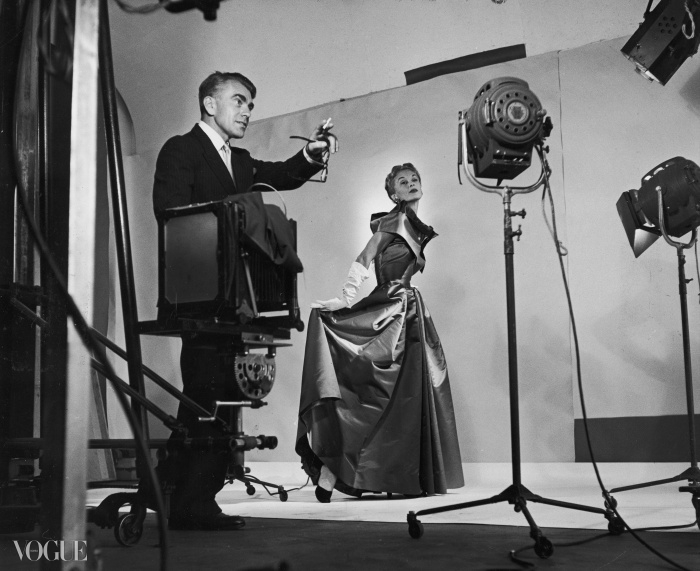
나는 플래티넘-팔라디움으로 인화하는 것이 어떤 의미인지 알 만큼 사진에 해박하지 않다. 그러나 예술, 사진, 그리고 패션 애호가라면 누구나 피상적인 모습이 담긴 작품의 깊이와 V&A가 그것을 선보이는 뛰어난 방식에 감탄하며 전시회장을 떠날 것이다.
www.vam.ac.uk/content/exhibitions/exhibition-horst-photographer-of-style
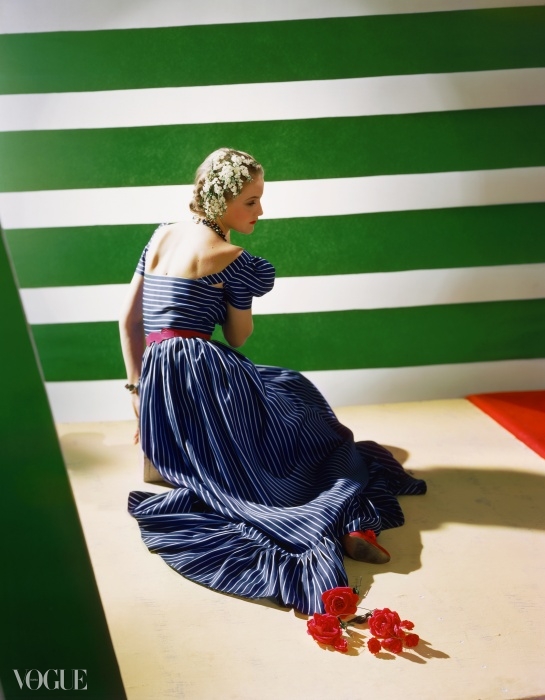
English Ver.
V&A’s Horst Exhibition Captures A Marvel BY SUZY MENKES
Suzy Menkes reviews the Horst exhibition at London’s V&A
Graphic black-and-white lines are drawn like a draughtsman’s plan. They run down a narrow space, following a geometric floor pattern, past the framed photographs of graceful models and down to a cluster of dresses on mannequins.
On the wall at the opening of this exhibition at the Victoria & Albert Museum in London is one word in stark, three-dimensional lettering: H O R S T.
The show is in homage to a photographer who went from Bauhaus to haute fashion over 60 fruitful years.
The result is a triumph for curator Susanna Brown, whose exhibition, Horst: Photographer of Style (until January 4), captures the man and his work with precision and clarity.
It starts with research into iconic photographs, showing the elegant chiaroscuro of light and shadow for which the photographer was famous in the Thirties.
It goes on to reveal Horst’s attachment to Salvador Dalí and the surrealists and his rigorous portraiture of stars of the silver screen, such as Rita Hayworth and Ginger Rogers. A final burst of colour appears as 94 Vogue magazine covers and 25 giant photographs, newly printed from the Condé Nast archive.
Throughout, the exhibition has a compelling energy and deep knowledge, but delicately expressed.
Susanna Brown has devoted a small part of the Horst show to the stylised eroticism of the photographer’s private work: the graphic intertwining of muscular male bodies in the Fifties that pre-dated the more explicit work of Robert Mapplethorpe in the Eighties. I noted that Horst’s body sculptures through the camera lens are loaned from the private collection of Elton John/David Furnish.
I have a particular affinity with Horst, although I never worked with him. Because when I was researching The Windsor Style – my book on the Duke and Duchess of Windsor – Valentine Lawford, Horst’s long-term partner, invited me to their home in Oyster Bay Cove in Long Island, where I glimpsed a lifetime of modernism, born from an apprenticeship with the architect Le Corbusier in 1930.
That streamlined style was interspersed with romantic touches such as the drawings of Christian Bérard; colourful, patterned Tunisian rugs; and the lush surrounding garden.
Valentine Lawford was still the same impeccably English foreign-office figure as when they had fallen in love in 1947. Together, we rummaged through shoe-box archives, looking at pictures of the Windsors at home in their Paris mansion with the debris of royal objects from before the abdication, and Wallis’s personal collection of Meissen pugs to match the live animals sitting at her feet.
Most of Horst’s work is exceptionally well known – meaning that these iconic pictures are familiar friends: Coco Chanel elongated on a sofa, her chiselled profile softened as she looks with love into the distance; Marlene Dietrich in her sober black suit and hat above smoky, lidded eyes.
And, of course, the photograph that really can be described as “iconic”: the laced Mainbocher corset from 1939 that was the last photograph Horst took before fleeing Paris for New York at the start of the war.
The models alone are legendary, sometimes part of society, like Gloria Vanderbilt, a pouting beauty in New York in 1941. Or the ever-present Swedish model Lisa Fonssagrives, as elegant in a Molyneux leopard skin coat as in classic black Chanel.
The curator calls Horst “a magician of light”. And she has found variations on the beautiful but familiar images, so that we can understand the process of the portraiture. For example, Carmen Dell’Orefice – the only Horst model still alive – is photographed having a face massage in 1946. The image is taken first straight on, then at a dramatic angle, as it was published.
In the well-researched book accompanying the exhibition, the model explains how Horst saw the classical beauty hidden behind her hair.
The clothes on show are from designers of the era such as Chanel, Lanvin, Maggy Rouff and Vionnet. They are not necessarily carbon copies of what is worn in the surrounding photographs, but have similar fashion gestures: liquid-metallic fabrics, or back ribbons and drapes that are reflected on the mirrored wall. The clothes are so tiny that the museum had to make bespoke mannequins.
The shock of moving from the first room of light and shadow to the bright, bold Dalí years is deliberate and effective. This section of Horst’s work with Elsa Schiaparelli and Dalí emphasises how much the visual arts were intertwined in that prolific Paris period before the two world wars.
Again, the exhibition comes up with surprises: there are Horst’s original pencil sketches of the Mainbocher corset image, while other drawing books are digitally installed so that the pages turn.
Another twenty-first-century effect is the instant access to the vast record of homes and gardens (including his own) photographed by Horst. A tap on a screen opens up pages of magazine articles.
I wished that the striking Vogue covers – starting in 1935 with Princess Sherbatow in red velvet – could also have been digitalised to show the magazines’ content.
Other elements of Horst’s oeuvre surprised me: the outdoor, post-war images of nature, showing close-ups of plants, shells and minerals – although I knew about the couple’s obsession with their Oyster Bay garden.
Just when you think this rich exhibition is coming to an end, there are other treats: a film of Horst directing a shoot, still looking like the young German boy who captivated Luchiano Visconti and Baron George Hoyningen-Huene, who mentored his protégé until pupil exceeded master.
I do not have enough photographic knowledge to grasp all the implications of the printing in platinum-palladium.
But any lover of art, photography and fashion would come away from the exhibition admiring the depth of such apparently superficial work and the excellent way the V&A has presented it.
http://www.vam.ac.uk/content/exhibitions/exhibition-horst-photographer-of-style/
인스타그램 @suzymenkesvogue
트위터 @SuzyMenkesVogue
페이스북 facebook.com/suzymenkes
최신기사
- 에디터
- 보그 인터내셔널 에디터 / 수지 멘키스(Suzy Menkes)
- 사진
- Courtesy Photos


